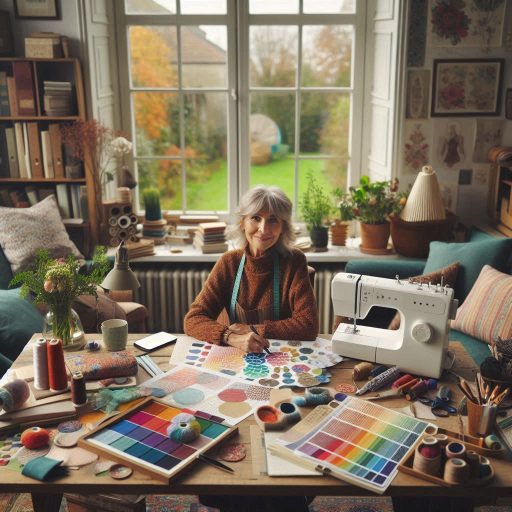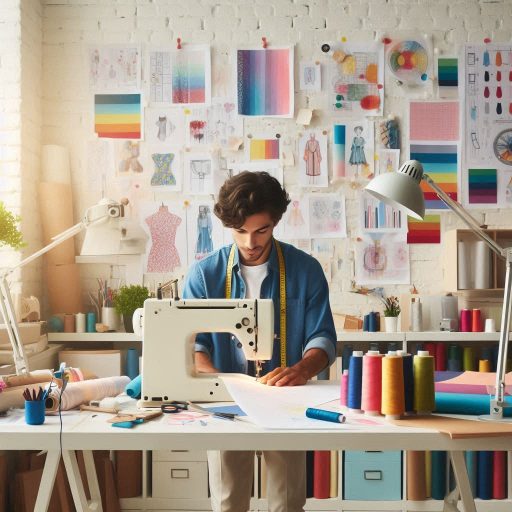Introduction
Textile design is a creative process involving the development of designs for woven, knitted, or printed fabrics.
It plays a crucial role in industries such as fashion, home décor, and automotive.
Textile design encompasses various stages, from initial concept development to final production.
Designers draw inspiration from sources like nature, art, or cultural influences to create unique patterns and textures.
The importance of textile design lies in its ability to transform a plain fabric into a work of art that adds value and aesthetics to products.
It allows brands to differentiate themselves in a competitive market by offering exclusive and innovative designs.
Designers must consider factors such as color, pattern, texture, and scale when creating textile designs.
They use digital software, hand-drawing techniques, and other tools to visualize and refine their concepts before moving to production.
Collaboration with manufacturers, suppliers, and clients is essential during the design process.
This ensures the final product meets quality standards and market requirements.
Communication and problem-solving skills are critical for successful textile design projects.
Conceptualization in Textile Design
In the world of textile design, the journey from concept to production is a critical and intricate process that demands careful thought, creativity, and meticulous planning.
Conceptualization serves as the first and foundational step in this journey, influencing the overall trajectory of the entire design process.
This phase is not just about generating ideas; it’s about crafting a vision that will guide every subsequent stage, from initial sketches to the final product.
Here, we will explore the key aspects of conceptualization, including how to gather inspiration, develop ideas, and create a cohesive theme through mood boards.
Exploring Different Design Inspirations
The first step in conceptualization involves immersing yourself in a diverse array of inspirations.
Designers should seek inspiration from various sources, including nature, art, culture, and technology.
- Nature: Observing the colors, shapes, and textures found in natural environments can spark unique design ideas.
Consider the vibrant hues of a sunset, the intricate patterns of leaves, or the smooth textures of pebbles.
Nature provides an endless supply of inspiration that can inform color palettes and material choices. - Art: Exploring different artistic movements and styles can also serve as a wellspring of inspiration.
Bold colors of Expressionism and delicate patterns of Art Nouveau inspire contemporary motifs and designs.
Artists’ works resonate with today’s audience, offering fresh insights and creative ideas. - Culture: Drawing from cultural heritage and traditions can add depth to your designs.
Investigate textiles from different cultures, paying attention to their historical significance, patterns, and color combinations.
This exploration can introduce unique elements that differentiate your designs in a competitive market. - Technology: Innovations in textile technology, such as digital printing and sustainable materials, can also inspire modern designs.
Understanding these advancements allows you to integrate cutting-edge techniques into your work.
Explore diverse sources of inspiration to identify textures, patterns, and colors that resonate with your design aesthetic.
This process will lead to innovative and compelling textile creations.
Developing Initial Sketches and Ideas
Once you have gathered a wealth of inspiration, the next step is to translate these ideas into initial sketches.
This phase is where your design concepts begin to take shape.
- Sketching: Start with rough sketches that capture the essence of your design vision.
These initial drawings should focus on various aspects such as shapes, motifs, and overall composition.
Don’t hesitate to create multiple versions of each idea; experimentation is key to discovering the best outcomes. - Refinement: After generating a series of sketches, take time to refine your ideas.
Evaluate which elements work well together and which need improvement.
This iterative process helps you hone in on your design’s core message and aesthetic appeal. - Thinking Outside the Box: Encourage yourself to push the boundaries of conventional textile design.
This could mean experimenting with unexpected combinations of colors, integrating unconventional materials, or exploring innovative techniques.
By embracing creativity and open-mindedness, you can develop designs that stand out and captivate your audience.
Creating Mood Boards for Theme and Color Palette
A crucial aspect of the conceptualization phase is the creation of mood boards.
These boards serve as visual references that guide the design process and ensure cohesiveness in your work.
- Curating Your Mood Board: Gather images, fabric swatches, color samples, and other materials that reflect your textile design theme.
Use these elements to convey the desired mood effectively.
This curated collection should reflect the overall aesthetic and emotional resonance of your concept. - Defining Your Color Palette: The mood board is an excellent tool for defining your color palette.
By juxtaposing different colors and textures, you can see how they interact with each other, allowing you to refine your choices before proceeding to production. - Visual Reference: Throughout the design process, refer back to your mood board to maintain consistency in your theme and color choices.
This visual anchor can help you stay aligned with your original vision, ensuring that all elements of your design come together harmoniously.
Conceptualization is an exhilarating phase in the textile design journey where your creativity can flourish.
Explore various design inspirations, develop initial sketches, and create cohesive mood boards.
This approach establishes a solid foundation for a successful textile design process.
Embrace the boundless possibilities of this phase, as it is where your unique vision begins to take form and set the stage for the artistry that follows.
Read: Top Skills Needed for Art Educators and Instructors
Research and Development
Market Research
Before diving into the vibrant world of textile design, conducting comprehensive market research is crucial.
This step is foundational to understanding current market trends and consumer preferences.
Effective research involves analyzing existing products, studying competitor offerings, and identifying gaps in the market that your designs can fill.
Utilize surveys, focus groups, and online analytics to gather insights about what consumers are currently interested in.
Pay attention to seasonal trends, color palettes, and fabric choices that resonate with your target audience.
For instance, sustainable textiles are becoming increasingly popular, reflecting a shift toward environmentally conscious consumerism.
Staying updated on these trends will allow you to create textiles that not only stand out but also meet the evolving demands of consumers.
Material and Technique Experimentation
One of the most exhilarating aspects of textile design is the opportunity for experimentation with a wide array of materials and techniques.
The fabric you choose can profoundly affect the aesthetic and functional qualities of your designs.
Traditional materials like cotton, silk, and wool provide classic appeal and versatility.
Innovative materials such as eco-friendly textiles and bamboo fibers spark new avenues for creativity.
Recycled synthetics also contribute to this creative exploration.
Experimenting with various weaving, printing, and dyeing techniques can also yield unique textures and patterns.
For example, you might explore screen printing for bold graphics, or digital printing for intricate, multicolored designs.
Each technique can impart a different feel to your work and can set your designs apart from others in the market.
This experimentation process encourages you to think outside the box and discover new possibilities, making your designs distinctive and relevant.
Concept Refinement
After gathering valuable insights from your market research and experimenting with different materials and techniques, it’s time to refine your initial concepts.
This phase is critical for transforming your creative ideas into viable products.
Start by seeking feedback from potential customers or industry experts; their insights can provide perspective on your designs and highlight areas for improvement.
Conduct focus groups or informal interviews to understand how your target audience perceives your concepts.
Additionally, testing prototypes is essential to evaluate functionality, comfort, and overall appeal.
Use this feedback to iterate on your designs, making adjustments that align with consumer preferences while maintaining your artistic vision.
This refinement process not only enhances the quality of your final products but also increases their marketability.
The Importance of R&D
Engaging in thorough research and development (R&D) activities is vital in ensuring that your textile designs are both creative and aligned with market demands.
This proactive approach allows you to stay ahead of competitors and respond effectively to consumer trends.
Remember, innovation is key in the competitive world of textile design.
By embracing new technologies, sustainable practices, and cutting-edge materials, you position yourself as a forward-thinking designer.
Don’t hesitate to push boundaries and explore unconventional ideas, as this can lead to groundbreaking designs that captivate your audience.
Read: Collaborating with Other Creative Roles
Digital Design
Digital design plays a crucial role in modern textile production.
Designers use software like Adobe Illustrator and Photoshop for effective digital rendering.
These tools enable artists to create stunning visuals and intricate designs quickly.
Below, we explore key aspects of digital design in textile design.
Using Software for Digital Rendering
Software like Adobe Illustrator and Photoshop revolutionizes textile design.
These programs offer various features that enhance creativity and efficiency.
- Vector Graphics: Adobe Illustrator uses vector graphics, ensuring designs remain sharp at any scale.
- Layering Techniques: Designers can use layers to separate elements, making adjustments easy.
- Color Management: Both programs offer advanced color management tools for accurate color representation.
- Text Tool: Designers can incorporate text easily, allowing for unique branding opportunities.
Creating Repeat Patterns and Motifs
Repeat patterns are essential for fabric design.
Digital tools simplify the process of creating these patterns.
- Pattern Creation: Designers can create seamless repeat patterns by adjusting tile size and spacing.
- Motif Development: Digital design allows for quick iteration on motifs, enabling exploration of various styles.
- Scaling Patterns: Designers can easily scale patterns to fit different fabric types and dimensions.
- Color Variations: Quickly modify color schemes to suit different market trends and preferences.
Collaborating with Digital Designers
Collaboration enhances the design process, especially when working on tech packs and specifications.
- Tech Packs: Digital designers help create tech packs that contain essential information for production.
- Detailed Specifications: These packs include fabric details, measurements, and care instructions.
- Real-time Collaboration: Using cloud-based tools allows for real-time collaboration, streamlining communication between teams.
- Feedback Loops: Designers can share designs for immediate feedback, leading to quicker iterations and improved outcomes.
Benefits of Digital Design in Textile Production
Digital design offers numerous advantages that enhance the textile production process.
- Efficiency: Digital tools speed up the design process, reducing time from concept to production.
- Cost-effectiveness: Fewer physical prototypes are needed, lowering overall production costs.
- Versatility: Digital designs can be easily modified for different fabric types and applications.
- Sustainability: Reducing waste through fewer physical samples aligns with sustainable design practices.
Digital design has transformed textile production, making it more efficient and accessible.
Designers harness the power of software like Adobe Illustrator and Photoshop to create stunning patterns and motifs.
Collaboration with digital designers ensures accurate tech packs and specifications, streamlining the production process.
As the textile industry evolves, embracing digital design remains essential for success.
Read: Historic Costume Design Inspirations
Transform Your Career Today
Unlock a personalized career strategy that drives real results. Get tailored advice and a roadmap designed just for you.
Start Now
Prototyping
Collaborating with Textile Manufacturers
Collaborating closely with textile manufacturers during the prototyping phase is essential for achieving the desired outcome.
Manufacturers bring a wealth of expertise, knowledge, and resources to the table, which are critical for transforming your design concepts into tangible products.
This partnership is not merely transactional; it involves a deep understanding of each other’s capabilities and limitations.
Effective communication of your design specifications and requirements is crucial to this collaboration.
Clear, concise, and detailed communication ensures that manufacturers fully grasp your vision and expectations.
This clarity fosters a more productive working relationship, enabling manufacturers to align their production processes with your design goals.
Discuss the intricacies of fabric types, patterns, and construction techniques upfront.
This approach lays the groundwork for a successful prototype that reflects your creative intent.
Testing Material Durability
Testing the materials for durability is a critical aspect of the prototyping process.
The longevity of a textile is paramount, especially when considering its intended application in clothing or home furnishings.
Durable materials not only enhance the quality of the final product but also ensure customer satisfaction and brand loyalty.
Subjecting the prototypes to various stress tests such as abrasion resistance, tensile strength.
And weather resistance allows you to assess how well the material holds up under different conditions.
These tests simulate real-world usage, providing valuable insights into the textile’s performance.
Understanding the results of these durability tests is essential for determining the overall quality of the textile.
Which ultimately impacts the brand’s reputation and market success.
Ensuring Washability
Another key factor to consider during prototyping is the washability of the textile.
For products that require frequent cleaning, such as clothing and upholstery, it is crucial to test how the material reacts to washing.
Ensuring that a textile maintains its integrity through multiple wash cycles is vital for consumer satisfaction.
Evaluating the prototypes after washing provides insights into potential issues such as color bleeding, shrinkage, and loss of texture.
By closely examining these aspects, you can determine the practicality of the textile for everyday use.
Evaluating Color Fastness
Color fastness is another crucial consideration when prototyping textiles.
The ability of a fabric to retain its color when exposed to various environmental factors such as light, water, and heat is essential for maintaining the integrity of your design.
A textile that fades or bleeds colors not only compromises the aesthetic appeal but can also lead to customer dissatisfaction.
Conducting rigorous color fastness tests on the prototypes helps identify any potential issues early in the development process.
By simulating exposure to different conditions, such as laundering, light exposure, and humidity, you can assess the dye’s performance.
Making Adjustments Based on Feedback
Prototyping is inherently an iterative process that requires continuous refinement and improvement.
Feedback from manufacturers, testing results, and user experiences play a vital role in shaping the final product.
By actively seeking and incorporating feedback, designers can make informed adjustments that enhance the quality and performance of the textile.
This collaborative approach fosters innovation and creativity.
It allows designers to address issues that may arise during the prototyping phase, leading to a more polished final product.
The iterative nature of this process ensures that the final textile not only meets but exceeds expectations, ultimately leading to higher customer satisfaction.
Prototyping is a critical stage in the textile design process that bridges the gap between concept and production.
Designers collaborate closely with manufacturers.
They rigorously test materials for durability, washability, and color fastness.
Based on feedback, they make informed adjustments.
This process ensures the successful development of textiles that fulfill their intended purpose.
This comprehensive approach enhances the quality of the final product.
It also strengthens the partnership between designers and manufacturers.
This partnership paves the way for future collaborations in the ever-evolving textile industry.
Read: Freelance vs. In-House Costume Design Jobs
Production
Finalizing Design and Material Specifications
After navigating through the initial stages of conceptualization and design.
The next critical step in the textile production process is finalizing the design and material specifications.
This stage serves as a bridge between creative ideas and tangible outcomes, marking the transition from abstract concepts to actionable plans.
It involves making decisive choices regarding the exact colors, patterns, and textures that will be incorporated into the final textile products.
Partnering with Manufacturers for Bulk Production
Once the design and material specifications have been meticulously finalized, the next phase involves partnering with manufacturers for bulk production.
Finding reputable manufacturers is crucial for this step.
They must have the capabilities, resources, and expertise to produce textiles.
Ensure they can meet the established specifications.
Effective Communication
Effective communication is essential throughout this collaboration.
Designers must provide clear and detailed instructions to avoid misunderstandings or errors during production.
This includes sharing design specifications, material requirements, and any unique production techniques that need to be employed.
Regular check-ins and updates can further enhance communication, allowing for quick resolutions to any potential issues that may arise.
Quality Control Measures to Ensure Consistency and Standards
Quality control is a critical aspect of textile production, serving to maintain consistency and uphold industry standards.
Implementing robust quality control measures helps identify defects or issues in the production process.
This ensures the final product meets desired quality benchmarks.
Common Quality Control Practices
Several common quality control practices can be employed to safeguard the integrity of the production process:
- Regular Inspections: Conducting systematic inspections throughout the production process allows for the early detection of any inconsistencies or defects.
This proactive approach helps address issues before they escalate. - Durability and Performance Testing: Testing the textiles for durability and performance is essential to ensure they can withstand the demands of use.
This includes evaluating aspects such as colorfastness, tear strength, and resistance to wear. - Final Product Evaluation: After production, the final product should be rigorously evaluated against established standards.
This includes checking for color accuracy, pattern alignment, and overall craftsmanship.
Textile designers can confidently implement stringent quality control measures.
These measures ensure that products meet consumer expectations.
They also help maintain a positive reputation in the industry.
Consistent quality is key to building customer trust and loyalty, especially in a competitive textile market where differentiation is vital.
Implementing robust quality control measures helps identify defects or issues in the production process.
This ensures the final product meets desired quality benchmarks.
Each stage demands careful consideration and collaboration, ensuring that the final products are not only visually appealing but also of high quality.
By prioritizing these aspects, textile designers can navigate the complexities of production and deliver exceptional textiles that resonate with consumers.
Read: Essential Skills for Aspiring Costume Designers
Marketing and Promotion in Textile Design
Effective marketing and promotion play a crucial role in the success of textile design.
They help convey the unique aspects of your collection to potential buyers and retailers.
Here are key strategies to promote your textile designs successfully.
Creating Marketing Materials
Developing compelling marketing materials is essential for showcasing your collection.
Consider these options:
- Lookbooks: Design lookbooks that visually narrate your collection.
Include high quality images and descriptions to highlight key features. - Swatch Cards: Create swatch cards to provide tangible samples of your fabrics.
These cards should feature color options and texture details to help buyers make informed decisions. - Digital Presentations: Utilize digital platforms to create engaging presentations. Use animations or videos to bring your designs to life.
Showcasing at Trade Shows and Exhibitions
Participating in trade shows and exhibitions can significantly boost your visibility.
Follow these steps for effective showcasing:
- Choose the Right Events: Research and select trade shows that align with your target market.
Focus on those that attract your ideal buyers. - Engaging Booth Design: Design an eye-catching booth that reflects your brand’s identity.
Use banners, displays, and props that represent your collection effectively. - Interactive Demos: Offer interactive experiences at your booth.
Allow visitors to feel the fabrics and see the designs in action. - Networking Opportunities: Attend workshops and seminars during these events.
Use this time to network with other professionals in the industry.
Building Relationships with Buyers and Retailers
Developing strong relationships with buyers and retailers is vital for successful distribution.
Here are some strategies to foster these connections:
- Personalized Outreach: Reach out to potential buyers with personalized messages.
Highlight how your collection meets their needs and preferences. - Follow-Up Communication: After initial contact, follow up with potential buyers.
Send emails or schedule calls to keep the conversation going. - Attend Industry Events: Regularly attend industry events to meet buyers in person.
This face-to-face interaction can strengthen your connections. - Offer Exclusive Promotions: Provide exclusive deals or early access to new collections for retailers.
This strategy encourages them to prioritize your designs.
In the competitive world of textile design, effective marketing and promotion are crucial.
By creating impactful materials, showcasing your collection at events, and building relationships with buyers, you can successfully navigate the market.
Embrace these strategies to elevate your textile designs and reach your target audience.
Showcase Your Business Today
Reach thousands of readers actively exploring professional services. Publish your business profile and grow your audience now.
Publish NowConclusion
As we conclude, the journey of textile design from concept to production is a fascinating and intricate process that requires creativity, innovation, and collaboration.
Designers must constantly push the boundaries of their imagination.
They create unique and aesthetically pleasing designs that captivate consumers.
The importance of textile designers cannot be overstated, as they play a crucial role in shaping the fashion and home decor industries.
From designing patterns to selecting fabrics and colors, every decision made by a textile designer has a significant impact on the final product.
By understanding the needs and preferences of consumers, designers can create designs that resonate with their target audience and drive sales.
Textile design blends artistry and technical skill.
Designers continuously push the boundaries of fashion and interior design.
As we look to the future, it is clear that the role of textile designers will remain vital in driving innovation and creativity in the industry.
Through their passion and dedication, textile designers will continue to shape the way we dress and decorate our homes, leaving a lasting impact on the world of design.
[E-Books for Sale]
The Big Book of 500 High-Paying Jobs in America: Unlock Your Earning Potential
$19.99 • 500 High-Paying Jobs • 330 pages
Explore 500 high-paying jobs in America and learn how to boost your career, earn more, and achieve success!
See All 500 High-Paying Jobs of this E-Book
1001 Professions Without a Degree: High-Paying American Jobs You Can Start Now
$19.99 • 1001 Professions Without a Degree • 174 pages
Discover 1001 high-paying jobs without a degree! Unlock career tips, skills, and success strategies for just $19.99!




